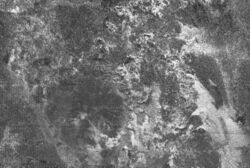Macula (planetary geology)
Topic: Earth
 From HandWiki - Reading time: 1 min
From HandWiki - Reading time: 1 min
Short description: Unusually dark area on the surface of a planet or moon

The Ganesa Macula on Titan is the large circular spot in the lower left of this image which was thought to be an ice volcano.
Macula /ˈmækjʊlə/[1] (pl. maculae /ˈmækjʊliː/) is the Latin word for 'spot'. It is used in planetary nomenclature to refer to unusually dark areas on the surface of a planet or moon.[2] They are seen on the icy surfaces of Pluto, Jupiter's moon Europa, Saturn's moon Titan, Neptune's moon Triton, and Pluto's moon Charon. The term was adopted for planetary nomenclature when high resolution pictures of Europa revealed unusual new surface features.[3]
Notes
- ↑ macula (3rd ed.), Oxford University Press, September 2005, http://oed.com/search?searchType=dictionary&q=macula (Subscription or UK public library membership required.)
- ↑ "Descriptor Terms (Feature Types)". Gazetteer of Planetary Nomenclature. International Astronomical Union (IAU) Working Group for Planetary System Nomenclature (WGPSN). Archived from the original on 2014-09-24. https://web.archive.org/web/20140924161413/http://planetarynames.wr.usgs.gov/DescriptorTerms. Retrieved 2014-08-26.
- ↑ Greeley, Ronald; Raymond M. Batson (2007). Planetary Mapping. Cambridge University Press. pp. 116. ISBN 978-0-521-03373-2. https://books.google.com/books?id=ztodv66A1VsC&dq=macula+triton+neptune&pg=PA116.
Links
Licensed under CC BY-SA 3.0 | Source: https://handwiki.org/wiki/Earth:Macula_(planetary_geology)4 views | Status: cached on September 18 2024 07:05:30↧ Download this article as ZWI file
 KSF
KSF